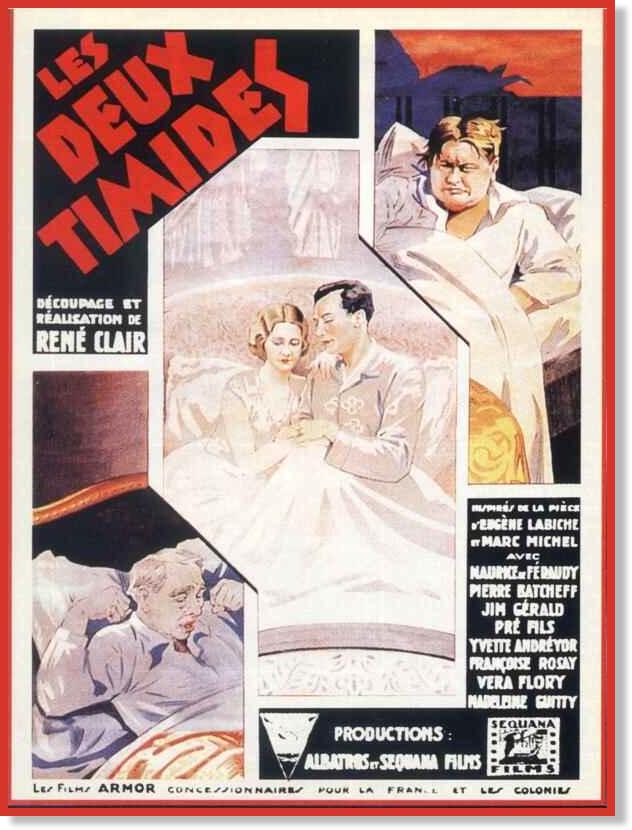Synopsis
Frémissin (Pierre Batcheff), a shy young lawyer, is the first of the timid souls of the title. The film opens with a farcical courtroom scene, where Frémissin spectacularly fails to defend his client, the burly, bullying Garadoux (Jim Gérald), who is on trial for abusing his wife. The story fast forwards to Frémissin failed attempts to ask Thibaudier (Maurice de Féraudy) - the second timid soul - for his unfortunate daughter Cecile's hand in marriage. Poor Cecile (Véra Flory), in love with Frémissin, finds herself stuck between two men who are seemingly unable to rise to any action of their own accord. Her father, in the meantime, has been bullied into accepting a proposal from Garadoux, who is now out of prison, a widower, and hiding his criminal past.
Source : fraser.typepad.com
Credits
Director (1)
Actors (13)
Production and distribution (3)
- Executive Producer : Les Films Albatros
- Film exports/foreign sales : Gaumont
- French distribution : Les Films Armor
Full credits (6)
- Executive Producer : Alexandre Kamenka
- Adaptation : René Clair
- Directors of Photography : Robert Batton, Nicolas Roudakoff
- Assistant Director : Georges Lampin
- Authors of original work : Marc Michel, Eugène Labiche
- Production Designer : Lazare Meerson
Technical details
- Type : Feature film
- Genres : Fiction
- Sub-genre : Comedy
- Production language : French
- Production country : France (100.0%)
- Original French-language productions : Unspecified
- Nationality : 100% French (France)
- Production year : 1928
- French release : 01/03/1929
- Runtime : 1 h 2 min
- Current status : Released
- Approval : Unknown
- Production formats : 35mm
- Color type : Black & White
- Aspect ratio : 1.33
News & awards
About
Les deux timides or "Two Shy Ones" was Rene Clair's last feature-length silent film. It was made in between of The Italian Straw Hat (1928) and Under the Roofs of Paris (1930). That is to say, in between of Clair's two, silent and sound, masterpieces. Due to this, Les deux timides has been left into oblivion. Surely the film doesn't have the wittiness of The Italian Straw Hat nor the avantgardist experimentalism of Entr'acte (1924) but what lifts it above many other silent comedies is its charming wit and playful attitude when it comes to the use of cinematic techniques. To my mind, it is a cheerful satire whose mockery hits marriage, the bourgeoisie and the judicial system.
At its heart, the film is a love triangle between two shy ones and a girl. It tells the story of an awkward lawyer who unintentionally gets his own client behind bars. But after three months or so, these two meet again. For the lawyer has fallen in love with a girl whose father is marrying her with the man who was the lawyer's client. The man threatens the young lawyer to leave the girl. Several misunderstandings take place but, in the end, love wins over -- as it very often does for Clair.
The film was made right before the breakthrough of synchronized sound and therefore is characterized by many references to the use of sound, such as the ear plugs of the maid. However, the most brilliant example of using images to express sound can be found from the two courtroom scenes: First, the words of the lawyer turn into images when he tries to shape his violent client into a decent husband -- an insightful realization regarding the falsehood of the facade of bourgeois love. This seems to be connected to the fact how in social comedy images are more ironic than words. In the later scene, both parties present untruthful and opposite testimonies which turn into a travesty of the society.
The way I see it, Clair wants to highlight how in bourgeois life nothing is certain or what they first seem to be; how there is no sense in anything. Their entire reality is reigned by different kind of misunderstandings and vacant rules of behavior. It is this from which Rene Clair always took his material -- impressionistic description of everyday life characterized by Dadaist ideology. Furthermore, one can clearly note the trade marks of his style in Les deux timides: the melancholy and nostalgic Parisian milieus, movement in the zone between dream and reality, ironic satire combined with moral study.
It is characterized by lively and poetic visuals, typically for Clair, but also by the perfect control of cinematic technique: the innovative use of split-screen effects and cross image, both of which have regularly been associated with the films by Abel Gance. But above all, it is its tender comics and sentimentality that seem to appeal to people. Les deux timides is indeed a very charming film but its entirety feels a little clumsy. Nonetheless, this shouldn't let one skip the film, for it is an astonishing accomplishment made during the heyday of the silents.
Source : IMDb.








































